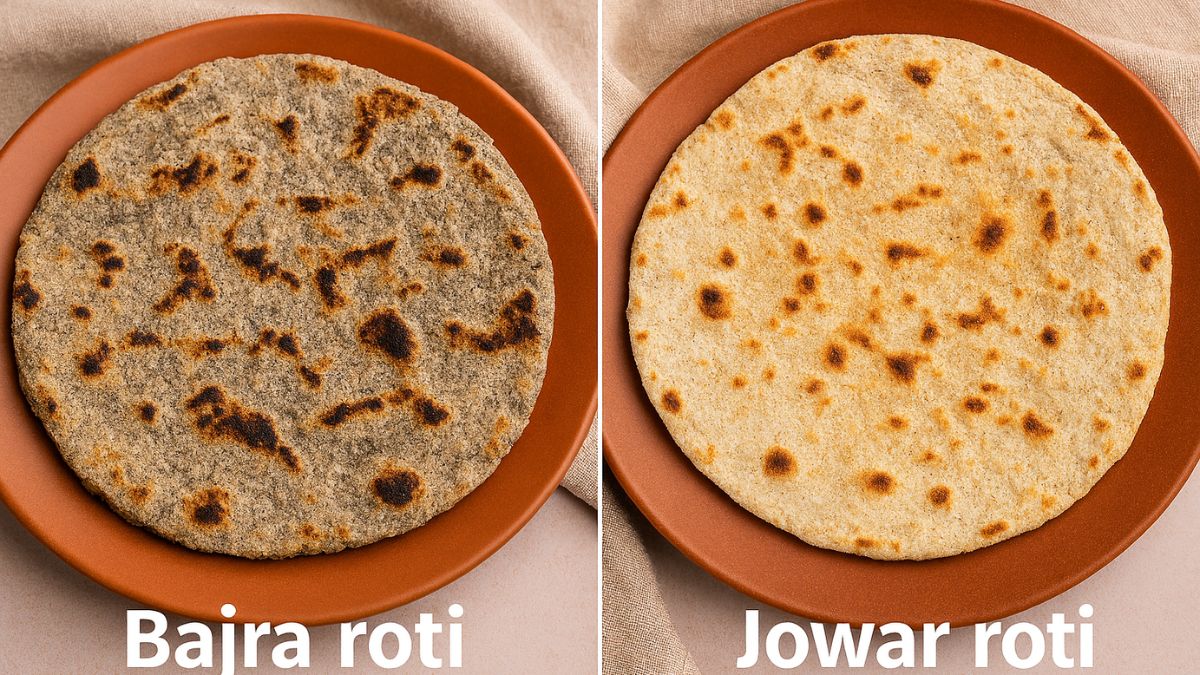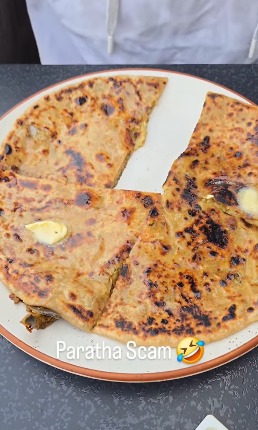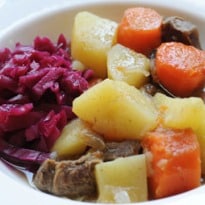Felicity Cloake tries out your local recipes.
Judging by this week's haul of local favourites, British food is at its very best at teatime. I only wish I'd had the space to try Cornish splits, Yorkshire fat rascals, bara brith and the many more wonderful regional baking recipes you sent my way.
I couldn't resist a chance to forage for some wild garlic, though - your nose should still lead you to some in damp shady areas this bank holiday weekend - or have a go at the luscious Lincolnshire plum bread. But it was scouse that really surprised me. How could something so simple, and so cheap, taste so good? Definitely a recipe for our times.
The winning recipe: Scouse
Here's my recipe for the local dish of Liverpool. No two recipes are the same but everyone says theirs is authentic. I like mine (which is my mum's, and in turn my nan's) because it is so simple and relies on good ingredients. You can also make "blind scouse" for vegetarians, a meat-free variant traditionally made in hard times.
Serves 6
400g shin beef
6 carrots
2 medium onions
2½ beef stock cubes
5-6 large waxy potatoes
White pepper
1 Cut the beef into 2cm cubes and take off most of the fat. Chop the carrots and onions roughly. Put it all in a large pan, cover with cold water and bring to the boil.
2 Skim the froth from the top of the stew. Add the stock cubes and a little white pepper and cook on a low heat until the meat is tender. Leave to cool.
3 Peel the potatoes and chop into cubes. Bring the stew back to the boil and add the potatoes. Cook until tender and season to taste.
4 Serve in a bowl with bread and pickled beetroot, red cabbage, tomato ketchup or brown sauce.
Lesley Davies, Liverpool
Cranachan
I've been in love with this seasonal dessert since I first moved to Scotland. All the ingredients are local and complement each other perfectly. I've modified the traditional recipe slightly by adding another local speciality, crowdie cheese, to give the cream texture and acidity. This dessert is best after a walk in the hills, using wild raspberries collected by hand.
Serves 4
60g pinhead oatmeal
200ml double cream
150g crowdie cheese (or curd cheese)
2-3 tbsp malt whisky
4 tbsp Scottish heather honey
300g raspberries
1 Toast the oatmeal in a hot, dry pan for a few minutes and leave to cool.
2 Whip the cream until thick, then fold in the cheese, whisky and honey.
3 Crush 200g raspberries into a puree. Fold the fruit puree lightly into the cream mixture to create a ripple.
4 Spoon half the cream mixture per portion into a glass, top with half the toasted oatmeal and raspberries and repeat the process once more, finishing by decorating with the remaining raspberries and oatmeal.
Marie-Joelle Schmidt, Edinburgh; auldfoodallianz.blogspot.com
Chilli paneer
This dish is thought to have originated from Kolkata's large Chinese community. Traditional Indian ingredients are given a Chinese spin to make one of the region's favourite dishes. This is my interpretation.
Serves 2 as a main dish
1 tbsp vegetable oil
½ tsp turmeric
2 garlic cloves, minced
1-2cm chunk of ginger, grated
1 small chilli, seeds discarded, thinly sliced
1 onion, cut into 2cm chunks
1 red pepper, cut into 2cm chunks
1 yellow pepper, cut into 2cm chunks
225g paneer, cut into approx 2cm chunks
2-3tbsp dark soy sauce
2 spring onions, chopped, white parts only
Small pinch of chilli flakes (optional)
Salt and white pepper
1 Heat the oil in a frying pan and add the turmeric, garlic, ginger and chilli. Cook for 2-3 minutes, then add the onion and peppers. Cook for a further 5 minutes before adding the chunks of paneer. Cook for 2-3 minutes more.
2 Add the soy sauce and stir to coat the paneer and vegetables. Season with salt and white pepper, and cook for a further 5-10 minutes until the paneer is golden on the outside.
3 Sprinkle spring onion and chilli flakes, if using, on top and serve with roti, naan, pitta, or another flatbread.
Natalie Wong, London, twinnydip.blogspot.co.uk
Wild garlic pesto
There's nothing more local than my back garden! Wild garlic can be found right now in wooded areas and it's easy to sniff out. My children adore this pesto on spaghetti with some steamed broccoli thrown in. It's an easy and delicious recipe that stores well.
Makes 250g
250g wild garlic leaves (including buds and flowers to scatter on the pasta)
125g roasted skin-on hazelnuts or walnuts
50g parmesan or pecorino, grated
50ml extra virgin olive oil, plus extra
1 Pick, wash and dry the wild garlic. Remove the primary veins and stalks for a smooth pesto.
2 Put the leaves in a food processor along with the roasted hazelnuts and grated cheese and blend to a slightly coarse paste. Pour in the olive oil while blending.
3 Season with salt and pepper to taste. Use immediately, stirred into freshly cooked pasta. Leftovers can be stored in the fridge for up to a week in an air-tight container covered with a splash more oil.
Jess Baum, Bristol; themotherinlawskitchen.wordpress.com
Lincolnshire plum bread
This is a Christmas tradition in Lincolnshire, although you will see it year-round in bakeries throughout the region. It probably dates back many centuries. This recipe was given to my mum when we lived in Lincolnshire in the early 60s.
Makes 4 loaves
110g lard or white vegetable fat, plus extra
110g butter
900g strong white bread flour
2 tsp mixed spice
2 tsp ground cinnamon
900g mixed dried fruit and peel
350g soft brown sugar
25g fresh yeast (or 2 x 7g packet of fast-action dried yeast)
2 eggs, beaten
About 200ml milk
1 tsp salt
1 Rub the fats into the flour and add the salt and spices. If using fresh yeast, mix it with a little water and sugar and allow it to bubble and "work". It will be frothy when it is ready to use.
2 Add the fruit and sugar to the flour mixture, then add the yeast (or the dried yeast if using), eggs and enough milk to give a soft dough.
3 Knead the mixture for at least 10-15 minutes in batches and then leave to rise for up to 3 hours in a warm place, covered with a teatowel.
4 Grease 4 x 450g loaf tins and divide the mixture equally between them, then leave to rise in a warm place, covered, until they have almost doubled in size. Preheat the oven to 200C/400F/gas mark 6.
5 Bake the loaves for 40 minutes to an hour, until well risen and light brown; they should sound hollow when tapped underneath.
6 Allow to cool slightly in the tins, before removing to a wire rack, and leaving to cool completely. Store in an airtight container, or wrap in clingfilm and foil and freeze.
7 Slice and serve warm with butter, or a slice of cheese.
Karen Burns-Booth, Malton, North Yorkshire; Lavenderandlovage.com
Mushy peas
Restaurants in Dordogne serve them under the name of pois détrempés; in Italy they are commonly known as piselli pastosi and, of course, the Spanish love nothing more than a tapas of guisantes fofos. But here up north they're simply "mushy peas". And they're reet good.
Serves 4
300g dried marrowfat peas
2 tsp bicarbonate of soda
Knob of butter
1-2 tsp mint sauce (optional)
1 Start by soaking the peas overnight (or for at least 12 hours) in plenty of cold water mixed with the bicarbonate of soda (the more you use, the mushier the result). The peas will expand to about 3 times their size, so make sure you have a large enough bowl and sufficient water.
2 Drain the peas and place in a saucepan. Cover (just) with cold water, bring to the boil, turn down the heat, and simmer until the peas are at your preferred level of mushiness. Keep an eye on the water level and top up if it looks like it is getting too dry.
3 Stir in a knob of butter and season to taste. If using, stir in some mint sauce. Serve as an accompaniment to whatever you fancy, or as a snack on its own with a splash of malt vinegar.
Richard Camps, Hebden Bridge; yumblog.co.uk
The winning recipe, Scouse. Photograph: Jill Mead for the Guardian









